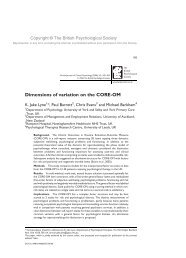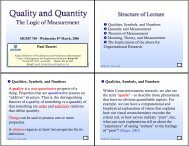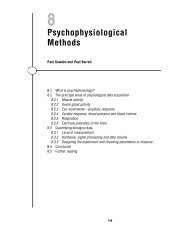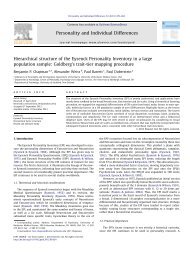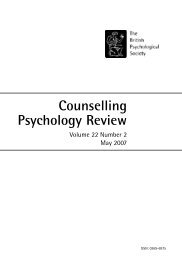95 - Paul Barrett
95 - Paul Barrett
95 - Paul Barrett
Create successful ePaper yourself
Turn your PDF publications into a flip-book with our unique Google optimized e-Paper software.
Measurement, 6: 78–123, 2008Copyright © Taylor & Francis Group, LLCISSN 1536-6367 print / 1536-6359 onlineDOI: 10.1080/15366360802035521Downloaded By: [<strong>Barrett</strong>, <strong>Paul</strong>] At: 20:46 27 June 2008COMMENTARIESThe Consequence of Sustaining aPathology: Scientific Stagnation—a Commentary on the Target Article“Is Psychometrics a PathologicalScience?” by Joel Michell<strong>Paul</strong> <strong>Barrett</strong>Hogan Assessment Systems, Inc.For more than 20 years now, Joel Michell has carefully explicated the propertiesand requirements of quantitative measurement, in books, papers, conferencepapers, and workshops. In 1997, he published what was essentially one ofthe most important papers in the whole of psychology for a generation, titled“Quantitative Science and the Definition of Measurement in Psychology.”As Michell notes in his target article, the response from psychologists andpsychometricians alike has been largely silence. From my own attempts torelay his thesis in papers, conferences, and academic seminars, I have beenmet with a mixture of disbelief, disinterest, anger, accusations of intellectualnihilism, ridicule, and generally a steadfast refusal to seriously question thefacts. And, make no mistake, Michell deals with facts about measurement. Theonly coherent responses I have read where the author made a passable attemptat really engaging with Michell’s work was in the book Measurement: Theoryand Practice by Hand (2004), a mathematical statistician and machine learningexpert, and Borsboom and Mellenbergh (2004) in a direct response to the paperpublished earlier by Michell (2000).Correspondence should be addressed to <strong>Paul</strong> <strong>Barrett</strong>, Chief Research Scientist, Hogan AssessmentSystems, Inc., 2622 E 21st Street, Tulsa OK 74114. E-mail: pbarrett@hoganassessments.com
COMMENTARIES 79Downloaded By: [<strong>Barrett</strong>, <strong>Paul</strong>] At: 20:46 27 June 2008Although many who read the current exposition by Michell might againchoose to “look the other way” or otherwise downplay the significance of hisstatements, for those who actually engage in empirical psychological science,rather than as Kline (1998, p. 197) put it “atheoretical response counting, theprovince of clerks,” Michell’s observations will hit hard. There are real-worldconsequences to his thesis, and we are living through them right now. The mostimportant of these is that while psychometricians have advanced their thinkingand technical sophistication in leaps and bounds over the past 40 years or so,the practical consequences have been almost nonexistent except in the domainof educational testing and various examination scenarios.The whole point of establishing a metric for a variable is presumably so we canmore precisely explain variations in the magnitudes of phenomena we observe—relating orders or perhaps even standard units of magnitude of the hypothesizedvariable to observed empirical outcomes. As we move from classes, to simpleorders, to a standard unit around which ratios of magnitudes of quantity mightbe expressed, so will the precision with which we describe variation increase.But, paradoxically, the accuracy of our description will actually decrease if weassume we are measuring a quantitative variable when in fact our empiricalobservations may support only simple orders.For example, what if psychological variables are not quantitatively structured,but we proceed anyway to treat them as if they were? What are the likely consequenceswhen we come to use these variable magnitudes to explain or predictthe phenomena we consider important for their validity? Well, just think whathappens if we make measurement of length with a ruler whose units vary insize over the length of its scale. Then, using this ruler, we seek to measurethe various heights of individuals. What happens is that we would observe anapproximate order between our measures and the empirical observations of theseindividuals. Some individuals would be observed to be taller than their measuresseem to indicate, some shorter. Some investigators might rightly conclude thatthe empirical observations are veridical and conclude that something is wrongwith the measuring process. Psychometricians and IRT/latent variable theoristsinstead seem to find ways to avoid explaining the lack of concordance of observationswith their measures by treating the error as “necessary” (as in IRT),or develop assumption-laden methods of “correcting” data for “artifacts whichcause attenuated relationships” (as in meta analysis), or begin to exaggerate theverbal description of what are essentially inconsequential analysis results, or asin interpretation of statistical parameters such as estimates of correlation, the linkbetween the magnitude of a parameter to its accuracy of explanation is subverted(Hemphill, 2003).The real-world consequences of this systematic aversion to properly consideringthe presumed status of a psychological variable is that our journals arenow filled with studies that are largely trivial exemplars of mostly inaccurate
80 COMMENTARIESDownloaded By: [<strong>Barrett</strong>, <strong>Paul</strong>] At: 20:46 27 June 2008explanations of phenomena. Nothing seems to have changed since Lykken’ssimilar observations of this phenomenon back in 1991. Sophisticated statisticalmodels are now used to produce results that seem to have little real-worldpractical or even scientific consequence. For those who might doubt this, tryand name just one result from the application of psychometrics in the last 50years which has yielded a finding so important that it has changed the courseof investigation and understanding of a phenomenon. There are a few of thesewithin the recent empirical science of psychology and neuroscience, such asGigerenzer and colleagues’ work on fast and frugal heuristics (Gigerenzer &Todd, 1999) and Gould and colleagues’ work on neurogenesis (Gould, Tanapat,McEwen, Flugges, & Fuchs, 1998), neither of which rely on the kinds of statisticalmachinations employed by those who seek to create “measures” from whatare mostly questionnaire responses.For example, Freedman (2004, p. 200) states the following at the end of hisbook Statistical Models, Theory and Practice:In the social and behavioral sciences, far-reaching claims are often made for thesuperiority of advanced quantitative methods—by those who manage to ignore thefar-reaching assumptions behind the models. The goal of empirical researchis—or should be—to increase our understanding of the phenomena, rather thandisplaying our mastery of technique.And, I am not alone in pointing out that psychometric test theory has yieldedlittle of scientific value. Blinkhorn (1997, p. 175), in a review of 50 years of testtheory, states the following in the abstract to his paper:Contemporary test theory, with its emphasis on statistical rather than psychologicalmodels, has become inaccessible to the majority of test users, and predominantlyreflects educational rather than psychological concerns. Real progress may dependon the emergence of a new and radical reconceptualization.What kind of science promulgates the fundamental requirement for IRT that, asMichell puts it in is target article, “improving the precision of our observationalconditions decreases the precision of our observations”? Andrich (2003, p. 27)has tried to provide an answer to this “paradox” in a recent paper, stating thatthe need for probabilistic models in the social sciences does not result from lackof precision in the data, but the contrary; it implies that social scientists who workin the units of their measuring devices may need probabilistic models just becausethey are working at precise levels relative to the variation of the values of thetraits they are measuring. To support this perspective, it was observed that, wheremeasuring devices in the physical sciences have become very precise, that is at thequantum level, probabilistic formulations have been invoked.
COMMENTARIES 81Downloaded By: [<strong>Barrett</strong>, <strong>Paul</strong>] At: 20:46 27 June 2008This is a peculiar line of reasoning for two reasons. First, what are these“precise levels” at which psychologists work? The precision is accorded by thequite arbitrary use of a real-valued, additively structured, numerical relationalsystem with arbitrary units, which forms the imposed quantitative structure ofthe latent variable. Precise it may be, but the assumed one-to-one relationshipbetween the numerical relational system and the observed empirical relationalsystem is rarely tested, as Michell (this journal) notes. Second, the argument thatphysicists have to use probabilistic models because of the increased precisionof their measuring devices is somewhat inappropriate. For example, Penrose(1997) notes that the accuracy of deterministic Newtonian mechanics is about10 –7 , that of Einstein’s relativity is about 10 –14 , and that of quantum mechanicsis about 10 –11 . Measurement at the deterministic level in physics is so farbeyond the precision of any measurement we can make of any psychologicalvariable that Andrich’s arguments are rendered irrelevant for that reason alone.However, the implied inference—that because measurement made at the quantumlevel of the physical world requires a probabilistic formulation of events, sotherefore do psychometric models—ignores the reasons why a probabilisticformulation was required in quantum mechanics. These involve a change inperspective of the very nature of causality (nonlocal quantum entanglement)and Heisenberg’s uncertainty principle (Giancoli, 1988), which states that wecannot simultaneously measure both the position and the momentum of an objectprecisely. However, if Andrich is indeed recommending that the worldview ofquantum physics should be adopted by psychologists, well, that is somethingelse entirely.In the end, none of what Michell states is actually that difficult or complex tounderstand. As he notes, we can barely specify the relations between variablesand their measures beyond a simple order. We have no body of sufficientlydetailed theory as to why we can even observe such orders for the vast majorityof these variables. Instead of simply “dealing” with this state of affairs asscientists might, which is to think about why it is proving so difficult and perhapsconcentrate more on methods for establishing some decent levels of predictiveaccuracy of whatever we hold as “important,” psychometricians have insteadcreated a self-sustaining illusion that data-model-driven statistical complexityequates to more accurate science. Where is the evidence for this proposition?For example, look at the revolution in the area of risk prediction of recidivismin forensic psychology. Society and the courts required more from forensicpsychologists than “clinical hand-waving” when it came to predicting risk ofrecidivism and dangerousness (Ziskin, Faust, & Dawes, 19<strong>95</strong>). The best tool forpredicting violent recidivism, the Violence Risk Assessment Guide (Webster,Harris, Rice, Cormier, & Quinsey, 1994), turns out to be a straightforwardbehavioral checklist, using a simple integer importance-weighting scheme forits items, which, when summed, produces a classification accuracy of 72%, and
82 COMMENTARIESDownloaded By: [<strong>Barrett</strong>, <strong>Paul</strong>] At: 20:46 27 June 2008has been replicated in many countries since—no structural equation modeling,no data-model-driven regressions, no “made-up” latent variables, and, aboveall, no assumptions made as to the “quantitative” nature of the scale of riskpropensity. Clearly, the understanding behind why it works is limited, and thereis no obvious set of sufficiently detailed theoretical propositions that could betested to explain the many behavioral constituents of this risk scale; this willcome over time. But it works, to a quantified degree of predictive accuracy, andhas changed international forensic-legal practices.Given the work by Fan (1998) and the recent PhD thesis by Courville (2004),showing that IRT latent variable yields “scores” and parameter estimates whichare not appreciably different from simple sum-score test theory, clearly, thedebate over the superiority of modern “latent variable” psychometrics as partof an investigative science over “back of the matchbox” use of sum-scores ispointless. The fact of the matter is that both seem to work equally as well inproducing what are essentially the same scores, when properly representativesamples of questionnaire data are analyzed.The obvious conclusion is that if we are to generate progress in our science,increasingly sophisticated methods of statistical data-model analysis are notgoing to help. Something about the way we go about construing psychologicalvariables, their measurement, and their presumed causal relations is wrong.That’s where our efforts should be concentrated as scientists, not on yet morequestionnaire item test theory and assumption-laden structural latent variablemodels that ignore the fundamental issues of quantitative measurement. Wemight seriously consider whether psychology might be, for all intents andpurposes, a nonquantitative science best approached with variables that vary insimple orders and even just classes, and where equifinality (many causes of thesame observed outcome) is the order of the day (Richters, 1997).Adherence to modern psychometric dogma, inasmuch as I agree with Michellthat it is a pathology of science, is strangling innovation and creativity in areasconcerning the investigation of psychological phenomena. In 1997, Blinkhornconcluded his own review of 50 years’ of test theory with the following:A more radical view is that current styles of test theory simply have no more ofpractical value to offer, that the implicit assumptions which have guided researchfor nearly a hundred years place constraints on what can be achieved which haveno more elasticity, and that a new start is needed. It is not a story of failure but ofpragmatic success that has reached its limits, and indeed reached them some timeago.The challenge is to recover the element of surprise—astonishment even—which greeted the developments of the first decade of this century when effectivepsychological measurement was first demonstrated. For too long test theory hasconcerned itself with ever cleverer accounts of unimproved practical effectivenessand not with recommendations as to how to devise more effective tests. (p. 183)
COMMENTARIES 83Eleven years later, nothing has changed. If ever anyone needed convincing thatsustaining a pathology has consequences, this is it.Downloaded By: [<strong>Barrett</strong>, <strong>Paul</strong>] At: 20:46 27 June 2008REFERENCESAndrich, D. (2003). On the distribution of measurements in units that are not arbitrary. Epistemologyof Measurement, 42(4), 557–589.Blinkhorn, S. (1997). Past imperfect, future conditional: Fifty years of test theory. British Journalof Mathematical and Statistical Psychology, 50(2), 175–186.Borsboom, D., & Mellenbergh, G. J. (2004). Why psychometrics is not pathological: A comment onMichell. Theory & Psychology, 14(1), 105–120.Courville, T.G. (2004). An empirical comparison of item response theory and classical test theoryitem/person statistics. PhD thesis, Texas A & M University. Retrieved January 28, 2008, fromhttp://txspace.tamu.edu/handle/1969.1/1064Fan, X. (1998). Item Response Theory and Classical Test Theory: An empirical comparison of theiritem/person statistics. Educational and Psychological Measurement, 58(3), 357–381.Freedman, D. A. (2004). Statistical models: Theory and practice. New York: Cambridge UniversityPress.Giancoli, D. C. (1988). Physics for scientists and engineers with modern physics (2nd ed.). EnglewoodCliffs, NJ: Prentice-Hall International.Gigerenzer, G., & Todd, P. M. (1999). Simple heuristics that make us smart. Oxford, UK: OxfordUniversity Press.Gould, E., Tanapat, P., McEwen, B. S., Flugges, G., & Fuchs, E. (1998). Proliferation of granulecell precursors in the dentate gyrus of adult monkeys is diminished by stress. Proceedings of theNational Academy of Sciences, <strong>95</strong>, 3168–3171.Hand, D. J. (2004). Measurement: Theory and practice: The world through quantification. London:Arnold Publishers.Hemphill, J. F. (2003). Interpreting the magnitudes of correlation coefficients. American Psychologist,58(1), 78–79.Kline, P. (1998). The new psychometrics: Science, psychology, and measurement. New York:Routledge.Lykken, D. T. (1991). What’s wrong with psychology anyway? In D. Cicchetti & W. M. Grove.(Eds.), Thinking clearly about psychology. Volume 1: Matters of public interest (pp. 3–39).Minneapolis, MN: University of Minnesota Press.Michell, J. (1997). Quantitative science and the definition of measurement in psychology. BritishJournal of Psychology, 88(3), 355–383.Michell, J. (2000). Normal science, pathological science, and psychometrics. Theory & Psychology,10(5), 639–667.Penrose, R. (1997). The mysteries of quantum physics. In R. Penrose, A. Shimony, N. Cartwright,& S. Hawking (Eds.), The large, the small, and the human mind (pp. 50–92). Cambridge, UK:Cambridge University Press.Richters, J. E. (1997). The Hubble hypothesis and the developmentalist’s dilemma. Developmentand Psychopathology, 9(2), 193–229.Webster, C. D., Harris, G. T., Rice, M. E., Cormier, C., & Quinsey, V. L. (1994). The violenceprediction scheme: Assessing dangerousness in high risk men. Toronto, Canada: University ofToronto, Centre of Criminology.Ziskin, J., Faust, D., & Dawes, R. (19<strong>95</strong>). Coping with psychiatric and psychological testimony(5th ed.). Los Angeles, CA: Law and Psychology Press.



